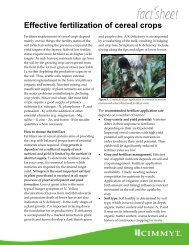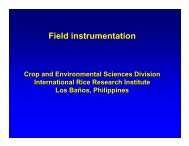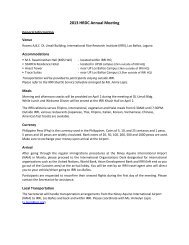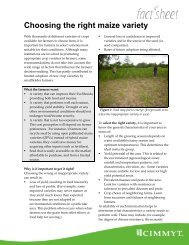Water management in irrigated rice - Rice Knowledge Bank ...
Water management in irrigated rice - Rice Knowledge Bank ...
Water management in irrigated rice - Rice Knowledge Bank ...
- No tags were found...
Create successful ePaper yourself
Turn your PDF publications into a flip-book with our unique Google optimized e-Paper software.
tive to water deficit than cell enlargement.Leaf area expansion is reduced as soon asthe soil dries below saturation (tensionshigher than 1 kPa) <strong>in</strong> most cultivars, andwhen only about 30% of the available soilwater has been extracted <strong>in</strong> cultivars withaerobic adaptation (Lilley and Fukai 1994,Wopereis et al 1996).2. Closure of stomata, lead<strong>in</strong>g to reduced transpirationrate and reduced photosynthesis.Leaf stomata do not close immediately withdrought stress, however, and the crop keepson photosynthesiz<strong>in</strong>g for a certa<strong>in</strong> periodbefore stomata close. The assimilates arenot used for leaf growth or expansion (seepo<strong>in</strong>t 1), but are stored <strong>in</strong> the exist<strong>in</strong>g leaves,stems, and roots. When drought stress isrelieved, these assimilates may becomeavailable and lead to a flush <strong>in</strong> leaf growth.In the modern high-yield<strong>in</strong>g variety IR72,stomatal closure starts at soil water tensionsof 75 kPa (Wopereis et al 1996).3. Leaf roll<strong>in</strong>g, lead<strong>in</strong>g to a reduction <strong>in</strong> effectiveleaf area for light <strong>in</strong>terception. Leafroll<strong>in</strong>g <strong>in</strong> IR72 starts at soil water tensionsof 75 kPa (Wopereis et al 1996). Leaves unrollaga<strong>in</strong> when drought stress is relieved.4. Enhanced leaf senescence, lead<strong>in</strong>g to reducedcanopy photosynthesis. Enhancedsenescence <strong>in</strong> IR72 starts at soil water tensionsof 630 kPa (Wopereis et al 1996).5. Changes <strong>in</strong> assimilate partition<strong>in</strong>g. Rootsgrow more, at the expense of the shoot,dur<strong>in</strong>g vegetative development, whereaspartition<strong>in</strong>g of assimilates among variousshoot components is not affected. Deeperroots are effective for explor<strong>in</strong>g water stored<strong>in</strong> deeper soil layers.6. Reduced plant height (though it is not likelythat reduced plant height <strong>in</strong> itself will result<strong>in</strong> yield reduction).7. Delayed flower<strong>in</strong>g. Drought <strong>in</strong> the vegetativedevelopment stage can delay flower<strong>in</strong>gup to 3 to 4 weeks <strong>in</strong> photoperiod-<strong>in</strong>sensitivevarieties. The delay <strong>in</strong> flower<strong>in</strong>g islargest with drought early <strong>in</strong> the vegetativestage and is smaller when drought occurslater.8. Reduced tiller<strong>in</strong>g and tiller death. Droughtbefore or dur<strong>in</strong>g tiller<strong>in</strong>g reduces the numberof tillers and panicles per hill. If the droughtis relieved on time, and the source size(i.e., photosynthesiz<strong>in</strong>g leaves and stems)is sufficiently large, the reduced number oftillers/panicles may be compensated for byan <strong>in</strong>creased number of gra<strong>in</strong>s per panicleand/or by an <strong>in</strong>creased gra<strong>in</strong> weight.9. Reduced number of spikelets with droughtbetween panicle <strong>in</strong>itiation and flower<strong>in</strong>g,result<strong>in</strong>g <strong>in</strong> decreased number of gra<strong>in</strong>s perpanicle.10. <strong>Rice</strong> is very sensitive to reduced wateravailability <strong>in</strong> the period around flower<strong>in</strong>gas this greatly affects spikelet sterility (Cruzand O’Toole 1984, Ekanayake et al 1989).Increased spikelet sterility with drought atflower<strong>in</strong>g results <strong>in</strong> decreased percentageof filled spikelets and, therefore, decreasednumber of gra<strong>in</strong>s per panicle. Especially atanthesis, there is a short time span whenspikelet fertility is especially sensitive todrought.11. Decreased gra<strong>in</strong> weight with drought afterflower<strong>in</strong>g.The above processes appear roughly <strong>in</strong> orderof crop development and/or severity of drought,though numbers 2–4 also occur <strong>in</strong> the reproductivestage. Some effects lead to irreversible processesof yield reduction, such as numbers 4, 9, 10, and11, whereas others may be restored when droughtis relieved, such as numbers 2 and 3, and othersmay be compensated for by other effects later <strong>in</strong>the grow<strong>in</strong>g season, such as numbers 1, 2, and 8.Drought may also affect nutrient-use efficiency bythe crop s<strong>in</strong>ce water flow is the essential means ofnutrient transport. How yield is f<strong>in</strong>ally affected bydrought depends on its tim<strong>in</strong>g, severity, duration,and frequency of occurrence. The most sensitivestage of <strong>rice</strong> to drought is around flower<strong>in</strong>g.15


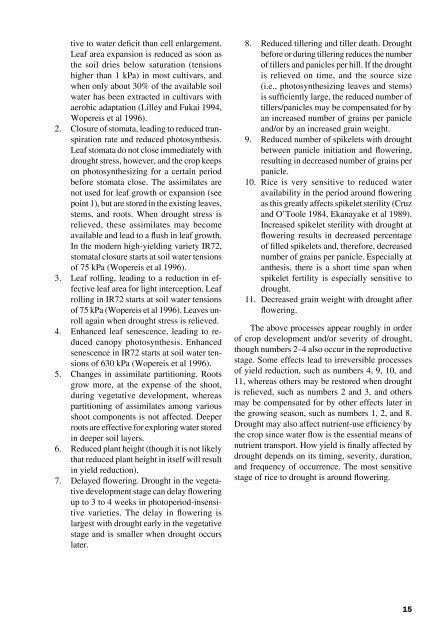


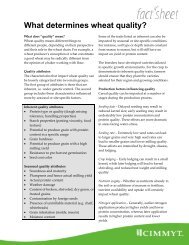

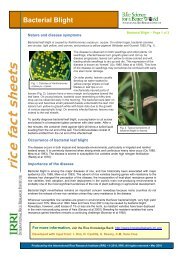

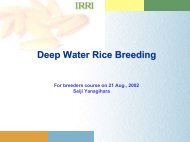
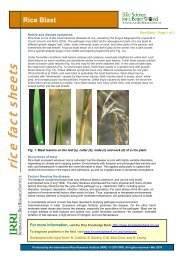
![International Standards' Organization â Rice Specification [ISO 7301]](https://img.yumpu.com/36696862/1/190x245/international-standards-organization-a-rice-specification-iso-7301.jpg?quality=85)

